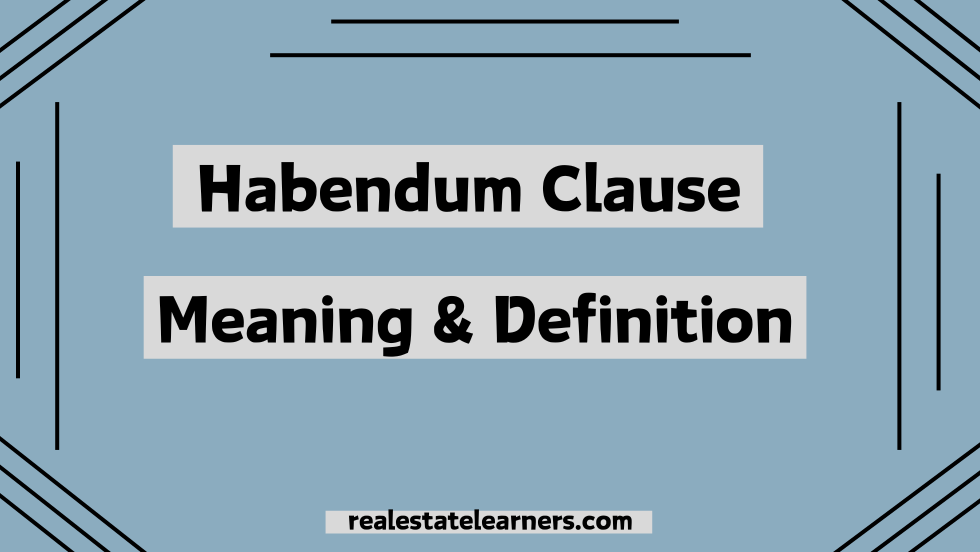In the world of real estate, there are many terms and clauses that can be confusing for both students preparing for real estate exams and agents. One such term is the “habendum clause”, which is commonly used in real estate contracts.
But what exactly does this clause mean? And how does it affect buyers, sellers, and real estate professionals? In this article, we will discuss the habendum clause in detail and break down its importance in habendum clause real estate
contracts.
What is a Habendum Clause?
A habendum clause is a legal document commonly found in real estate deeds and leases. It outlines the conditions under which the property rights are granted to the buyer or tenant, typically for land or buildings.
This type of clause is used to define the duration, extent, and limitations of ownership or tenancy. It may also include additional terms and conditions related to the property use and maintenance.
Habendum clauses can vary depending on the specific property transaction and applicable laws. However, most clauses will include the following elements:
Duration: This specifies the length of time for which the property rights are being granted. It may be a fixed term, such as a lease for 5 years, or it could be indefinite.
Restrictions or limitations: This outlines any restrictions or limitations on the use of the property, such as zoning restrictions or environmental regulations.
Rights and responsibilities: This section defines the rights and responsibilities of both the buyer or tenant and the seller or landlord. It can include details on taxes, insurance, maintenance, and other obligations.
Transferability: Some habendum clauses may also address whether or not the property rights can be transferred to another party. This can impact the future sale or subletting of the property.
Habendum clauses are important in real estate transactions as they provide legal clarity and protection for both parties involved. They help prevent misunderstandings and disputes by clearly outlining the terms and conditions of the property agreement.
What is Fee Simple Absolute in Habendum Clause?
Fee simple absolute is a type of property ownership that can be included in a habendum clause. It is the highest form of ownership and grants the owner complete rights and control over the property.
In a habendum clause deed, fee simple absolute means that the buyer or tenant has full and permanent ownership of the property without any restrictions or limitations. This type of ownership is often preferred by buyers or tenants as it gives them the most control and flexibility over the use and management of the property.
However, fee simple absolute can also have potential drawbacks. For example, the owner is solely responsible for all taxes, insurance, and maintenance costs associated with the property. Additionally, in some cases, local laws or regulations may limit certain uses of the property even under fee simple absolute ownership.
What is a Grant Clause in Habendum Clause?
A grant clause is another important component of a habendum clause. It is the section that explicitly grants the property rights to either the buyer or tenant. The language used in a grant clause can vary, but it typically includes phrases such as “conveys and warrants” or “bargains and sells.
” This indicates that the seller or landlord is legally transferring ownership or tenancy rights to the buyer or tenant. Grant clauses are necessary to ensure that the property transaction is legally binding and that the buyer or tenant has valid ownership or tenancy rights. Without a grant clause in a habendum clause, there may be doubts about the legitimacy of the property agreement.
What are the examples of habendum clause?
Lease Agreement: In a lease agreement, the habendum clause would outline the duration of the lease, any restrictions on property use, and the responsibilities of both the landlord and tenant. It may also include details on rent payments and security deposits.
Deed of Sale: When purchasing a property, the habendum clause in the deed of sale would specify the duration of the ownership, any restrictions on property use, and the rights and responsibilities of the buyer and seller. It may also include information on taxes and liens.
Land Contract: In a land contract, the habendum clause would detail the terms of financing for purchasing land, including the duration of payments and what happens in case of default. It may also specify any restrictions on land use and maintenance responsibilities.
Easement Agreement: In an easement agreement, the habendum clause would outline the duration of the easement, any limitations or restrictions on its use, and the rights and responsibilities of both parties involved. It may also include details on compensation for granting the easement.
Joint Tenancy Agreement: In a joint tenancy agreement, the habendum clause would specify the duration of joint ownership, any restrictions on property use or transferability, and the responsibilities of each joint tenant. It may also include details on how taxes and expenses will be divided among tenants.
What is the difference between a habendum clause and a granting clause?
A habendum clause and a granting clause are two terms that refer to different parts of a legal contract, specifically in the context of property ownership. While both clauses may seem similar in function, they have distinct differences that are important to understand.
Firstly, let’s define what each clause refers to. A granting clause is a section within a contract where the property owner (grantor) transfers ownership of the property to another party (grantee). This clause typically includes details such as the names of both parties, a description of the property being transferred, and any conditions for the transfer.
On the other hand, a habendum clause is a section within a contract that outlines how long the grantee will have ownership over the property. It specifies the duration or extent of the grantee’s interest in the property, which may be perpetual (forever) or for a specific period of time.
So, what is the main difference between these two clauses? The key difference lies in their purpose. A granting clause focuses on conveying ownership while a habendum clause focuses on defining the duration of that ownership. In other words, a granting clause establishes who owns the property, while a habendum clause determines how long they will own it.
Can habendum clause and a granting clause be used together?
Yes, a habendum clause and a granting clause can be used together in the same contract. In fact, they are often included in the same section or paragraph of a legal document.
This is because these two clauses work together to provide full clarity and protection for both parties involved in a property transaction. The granting clause ensures that ownership is legally transferred from one party to another, and the habendum clause specifies the terms of that ownership.
By using both a habendum clause and a granting clause, potential misunderstandings or disputes can be avoided as it clearly outlines the rights and responsibilities of each party involved in the property agreement.
Conclusion
In conclusion, the habendum clause is a crucial part of any real estate transaction. It outlines the rights and restrictions associated with the property being transferred from one party to another. This clause serves to protect both the buyer and seller by clearly defining their obligations and responsibilities.
Furthermore, understanding the importance of a well-written habendum clause can help avoid future legal disputes or misunderstandings.

Corey has over 15 years of experience as a real estate broker and educator. He is dedicated to providing valuable insights and guidance for those looking to enter the real estate industry.

